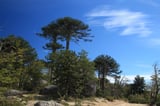This is based on the notion of adaptive radiation, a process in which organisms diversify rapidly from an ancestral species into a multitude of new forms, particularly when a change in the environment makes new resources available, creates new challenges, or opens new environmental niches.
The most popular example is the mammal class exploding with diversity in the aftermath of the Mesozoic-Cenozoic extinction event.
In this alternate MC extinction event, 65 million years ago, whole ecosystems around the world collapsed not because of a comet slamming into Mexico's Yucatán Peninsula, but a series of flood basalt eruptions in Siberia, releasing enough greenhouse gases to plague the entire world with extreme heat and drought.
The floral casualty list is as follows:
- Gnetophyta
- Ginkgophyta
- Cycadophyta
- Sciadopityaceae
- Araucariaceae
- Podocarpaceae
- Sequoioideae
- Bryophyta
- Marchantiophyta
- Anthotocerotophyta
- Pteridophyta
- Pteridospermophyta
Such a list would no doubt result in an overwhelmingly explosive adaptive radiation of the angiosperms, or flowering plants. Fast-forward to the 21st century, and the question isn't which flowering plant would fill in which void, but what would the landscapes look like?
What would today's marshes, bogs and swamps look like without the ferns, mosses or other waterlogged plants that we associate those habitats with?
Who will be the dominant trees of the rainforests of western North America, Chile or New Zealand?












